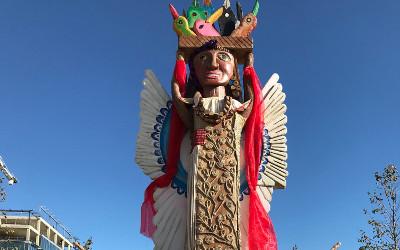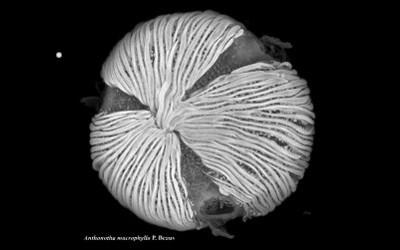OU researcher brings Indigenous peoples’ message to COP26

Professor of Religious Studies, Graham Harvey has worked with intercultural theatre company Border Crossings to bring a totem pole from Mexico to the UK with a powerful message about climate change’s impact on Indigenous peoples.
The 4.5 m high monumental carving stopped in Milton Keynes this weekend, en route to COP26, the UN Climate Change Conference in Glasgow from 31st October to 12th November.
Called Totem Latamat, Indigenous Totonac artist Jun Tiburcio carved the colourful artwork from a single tree during a ceremony to thank it for giving its life. The artist designed the totem to engage the public and politicians with the messages from the Indigenous people of its home nation. It carries the image of a man's head, the wings of an eagle and chiselled lines representing a message stretching 9000km from Mexico to London.
“Latamat” means “life” in Tutunakú, and the totem expresses Totonac spiritual ideas about the environment. It emphasises how deeply human existence is interwoven with nature, calls attention to the damage being done to the seas, the land and the air, and insists that we cannot ignore this destruction any longer.
Prof Harvey said: “Totem Latamat brings a message from Indigenous peoples to COP26 - and to everyone who encounters it – that celebrating and living responsibly among Earth’s life is the best reason for urgent action in the face of climate change.
“The experience and resilience of Indigenous peoples and cultures is worth listening to because while they comprise less than 5% of the world’s population, indigenous people protect 80% of our global biodiversity.”
Prof Harvey explained the particular significance of the hummingbirds at the top of the totem, saying these small birds are understood to be messengers who make the point that each of us becomes responsible for acting on the news or facts we hear or witness.
Discussing the links to his academic study he adds: “My research focuses on the ways in which Indigenous people use traditional ceremonies and narratives to address urgent contemporary issues. Most pressing among these is climate change.
“Long-term celebration of human kinship with the larger-than-human community (sometimes called “nature”) is the foundation of the ceremonies and stories that encourage respectful relationships. I’m interested in cultural festivals as well as political activism in which Indigenous people seek to convey a message of the need to respect life rather than irresponsibly consume everything.”
Totem creator Tiburcio, lives in a village and region which suffered major damage in a recent hurricane made more ferocious by climate change.
“The message of the totem is therefore not about a future threat but about the present experience of anthropogenic climate disaster. This makes his message (‘celebrate and live responsibly among all life’) eloquent and powerful,” said Prof Harvey.
Contact our news team
For all out of hours enquiries, please telephone +44 (0)7901 515891
Contact detailsNews & articles

Unlocking the secrets of pollen: OU’s role in a groundbreaking international digitisation project
In a transformative leap for the century-old science of palynology - the study of pollen - The Open University is helping in/contributing to a global effort to digitise and preserve one of the world’s most important botanical collections.